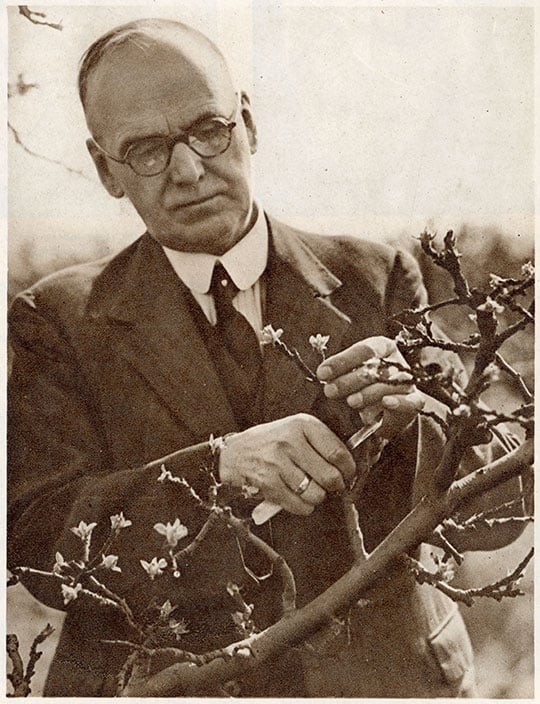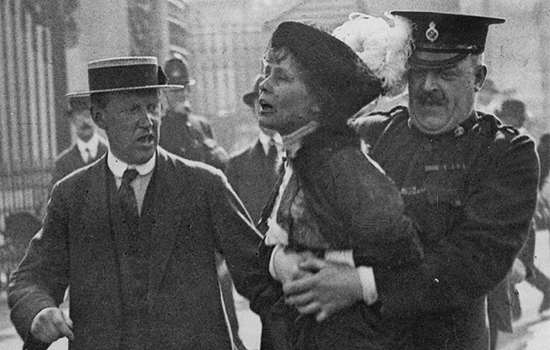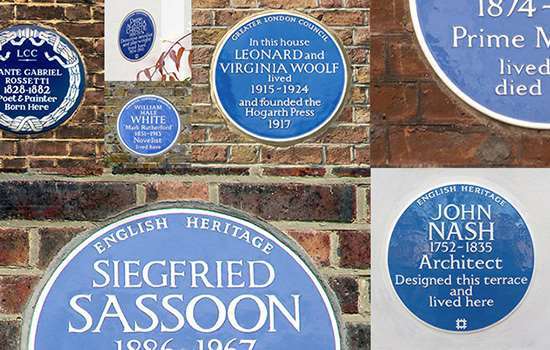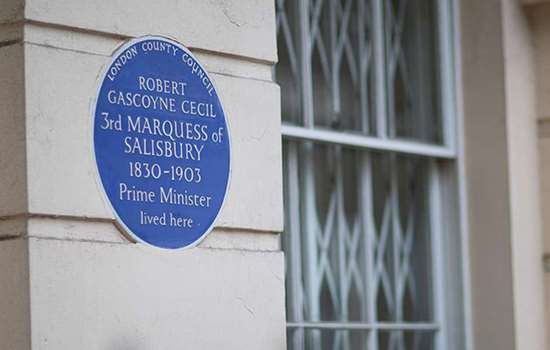MIDDLETON, C.H., ‘Mr Middleton’ (1886–1945)
Plaque erected in 2025 by English Heritage at 17 Princes Avenue, Tolworth, KT6 7JJ, Royal Borough of Kingston Upon Thames
All images © English Heritage
Profession
Gardener and Broadcaster
Category
Gardening
Inscription
C. H. MIDDLETON ‘Mr Middleton’ 1886–1945 Gardener and Broadcaster lived here 1928–1945
Material
Ceramic
Mr Middleton was a groundbreaking gardening broadcaster who became the voice of the wartime Dig for Victory Campaign. He was also a champion of the modest-sized plots behind houses just like his own. He is commemorated at 17 Princes Avenue, Tolworth, where he lived at the height of his fame.

Cecil Henry Middleton was born on 22 February 1886 in the village of Weedon Lois, Northamptonshire. His family lived in the gardener’s cottage on the Weston Hall estate, where his father was head gardener.
Middleton told of how ‘At seventeen, dressed in my Sunday suit and a flat little bowler hat, with 50 shillings and plenty of self-confidence, I came to London and got a job’. He was employed at the Feltham grounds of the prestigious firm James Veitch & Sons Ltd, and later at Dyson’s Lane nurseries in Upper Edmonton, where he worked in every department – seeds, market gardening, private gardening – and with chemicals used as fertilisers and insecticides.
Training and trains
When he applied to work at Kew Gardens in 1906, Middleton was an assistant gardener at Weston Hall and was given an excellent character reference. Although the medical officer reported ‘heart irregular, take with reservation’, Middleton was enrolled.
Kew was a turning point when his career became ‘more serious and interesting’. After heading Veitch’s new plant department, he moved to Stuart Low & Co’s Royal Nurseries at Bush Hill Park in Enfield. He married Rosa Annie Jenkins in 1912 and, as a horticultural instructor, he regularly contributed to the Gardeners’ Chronicle as ‘C. H. Middleton’.
During the First World War, Middleton worked for the Board (later Ministry) of Agriculture and Fisheries. His many lectures were widely reported, and he later became an expert demonstrator on the Great Eastern Railway’s Demonstration Train where he talked about produce and pest control. Between May and mid-June 1920, some 77,500 people had visited the train.
By February 1926, he had become a Fellow of the Royal Horticultural Society (RHS) and was appointed Surrey County Council staff lecturer. He was promoted to county horticultural adviser in 1928, a position he held until 1938.
Broadcasting
‘Good afternoon. Well it’s not much of a day for gardening, is it?’ began ‘Mr Middleton’ (as he was billed) in an early talk on ‘The Week in the Garden’ for the BBC. Recommended by the RHS, Middleton broadcast from 1931 and soon became gardening correspondent. ‘In Your Garden’, his long-running series of live talks, began in 1933 and continued, with only a short summer break each year, until May 1945. At its peak, between three and four million listeners tuned into his Sunday afternoon programme.
Middleton’s warm, no-nonsense, conversational style also suited the new medium of television: he appeared in many early ‘demonstrations’ from the first purpose-built TV garden, at Alexandra Palace. The ‘average’-sized plot had been laid out under his supervision in 1936.
In 1938, ‘the best-known man in the gardening world’ starred in a series of short films featuring both small gardens and those of Hampton Court and RHS Wisley. His talks were published in very popular books that were republished multiple times, among them Outlines of a Small Garden (1934), Mr Middleton Talks about Gardening (1935), and Mr Middleton Suggests (1938). Middleton’s All the Year Round Gardening Guide & Encyclopaedia of Gardening (1944) went into at least 14 editions. He also wrote a weekly Daily Express column and in 1938 became horticultural consultant to Boots, ‘the gardener’s chemist’.
Social contributions
A less well-known aspect of his work involved his dedication to school gardening. He planned primary school gardens and spoke on BBC school programmes and Children’s Hour. He was also quietly devoted to the Children’s Aid Society.
With the arrival of the Second World War, Middleton became the voice of the Dig for Victory campaign, writing a weekly column, ‘Your Garden in War Time’, and broadcasting live on ‘The Kitchen Front’, sponsored by the Ministry of Food. ‘Potatoes and beans are munitions of war as surely as bullets and shells’, he said, and as a model for others, he opened the Victory Produce Show at Weston Hall – where his 85-year-old father won three first prizes for vegetables.
Middleton retained a rebellious love for flowers though, and in 1941 he declared, ‘Hitler or no Hitler, war or no war, I’m going to grow a few bunches of sweet peas next summer’.
How to Dig
In this Pathé film from 1944, Mr Middleton showed the budding gardeners of Britain how to dig.
Life in Surbiton
Cecil and Rosa Middleton made their home and garden at 17 Princes Avenue, Tolworth, a new semi-detached house near the busy Tolworth Broadway. Its rectangular back garden was referenced in many of Middleton’s talks and books, with a characteristic blend of inspiration, humour and good sense. He admitted, ‘I only pay occasional visits to this garden and have neither time nor opportunity for chasing slugs or nursing the more delicate inhabitants, so it is more or less a case of the survival of the fittest’.
On 18 September 1945, Mr Middleton died suddenly outside his home. The cortege to the funeral service at St Matthew’s, Surbiton, was filmed by Pathé News and reported around the country. It was loaded with flowers: the finest hothouse blooms were sent by leading nurseryman, and chrysanthemums and Michaelmas daisies came from the ‘pocket handkerchief’ urban and suburban plots that he had encouraged people to cultivate.
Further reading
-
‘Cecil H Middleton, NDH’, Journal of Kew Guild, 1946, pp. 472–3 (pdf)
-
Jeff Walden, ‘Middleton, Cecil Henry (1886–1945)’, Oxford Dictionary of National Biography (2004) (access with a UK public library card)


